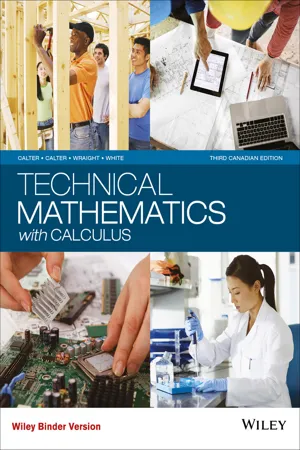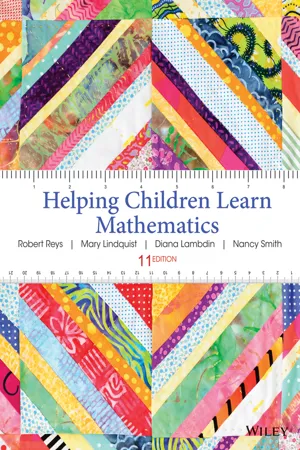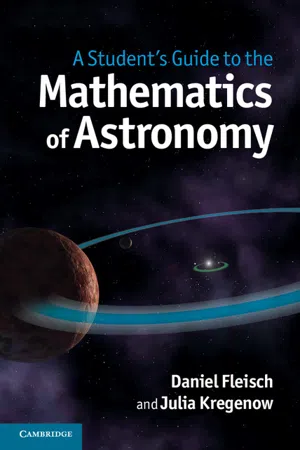Mathematics
Proportion
In mathematics, a proportion is a statement that two ratios are equal. It expresses the relationship between two sets of numbers or quantities. Proportions are often used to solve problems involving unknown quantities, and they play a key role in various mathematical concepts such as similarity and scaling.
Written by Perlego with AI-assistance
Related key terms
1 of 5
11 Key excerpts on "Proportion"
- eBook - PDF
- Tom Bassarear, Meg Moss(Authors)
- 2019(Publication Date)
- Cengage Learning EMEA(Publisher)
In this section, we have made explicit the difference between additive and multi- plicative comparisons. Like fractions, ratios and rates signify multiplicative relationships between two amounts. When two ratios are equal (or when two rates are equal), we have a Proportion. Thus, the concept of a Proportion connects to the notion of equivalent fractions, which we studied in Chapter 2. In the next section, we will build the concept of percent upon the concept of Proportion. We have examined several real-life applications of ratios, rates, and Proportions. In doing so, we found that it is critical to make sure that the computations make sense. We have given names to two methods that students often invent: the factor-of-change method and the unit-rate method. Dimensional analysis is one tool that helps us to solve Proportion problems. Finally, we have seen that many estimation problems involve Proportions. Section 5.1 Ratio and Proportion 261 6. If 1 3 4 cups of flour are required to make 30 cookies, how many cups of flour (to the nearest 1 4 cup) are required for 96 cookies? 7. In the summer of 1991, Israel airlifted 14,000 Ethiopian Jews to Israel as immigrants. If the United States were to receive a Proportional number of refugees at one time, about how many would be received? Say the population of Israel was approximately 4.4 million and that of the United States was 270 million. 8. a. On one map, 1 3 inch represents 18 miles. If two cities are 2 1 2 inches apart on the map, what is the actual distance between them? b. On another map, 1 inch represents 65 miles. Los Angeles is about 1000 miles from Portland. How many inches apart would Portland and Los Angeles be on this map? c. On a map 2 3 inch represents 84 miles. How far apart are two cities in reality if they are 4 5 8 inches apart on the map? 9. You can use Proportions to estimate the height of a tree. John is 6 feet tall, and his shadow is 10 1 2 feet long. - eBook - PDF
- Paul A. Calter, Michael A. Calter(Authors)
- 2011(Publication Date)
- Wiley(Publisher)
491 17 Ratio, Proportion, and Variation ◆◆◆ OBJECTIVES ◆◆◆◆◆◆◆◆◆◆◆◆◆◆◆◆◆◆◆◆◆◆◆◆◆◆◆◆◆◆◆◆◆◆◆◆◆◆◆◆◆◆◆◆◆◆◆◆◆◆ When you have completed this chapter, you should be able to • Set up and solve a Proportion for a missing quantity. • Solve applied problems using Proportions. • Find dimensions, areas, and volumes of similar geometric figures. • Set up and solve problems involving direct variation, inverse variation, joint variation, and combined variation. • Solve applied problems involving variation. • Set up and solve power function problems. ◆◆◆◆◆◆◆◆◆◆◆◆◆◆◆◆◆◆◆◆◆◆◆◆◆◆◆◆◆◆◆◆◆◆◆◆◆◆◆◆◆◆◆◆◆◆◆◆◆◆◆◆◆◆◆◆◆◆◆◆◆◆◆◆ We earlier described a ratio as the quotient of two quantities, say Here we will set one ratio equal to another to get a Proportion. We will learn how to solve pro- portions for a missing quantity. We next apply the idea of Proportions to the very important subject of similar figures. In technology we often have to relate an actual object to a drawing or model of that object—from a machine part to an engineering drawing of that part, from a geographical area to a map of that area, from a building to a scale model of that building. How do dimensions, areas, and volumes on one relate to those on the other? For example, if a one-fourth scale model of a space probe, Fig. 17–1, has a surface area of what is the surface area of the actual probe? Here we give you the tools to handle such problems. When two quantities, say, x and y, are connected by some functional relation, some variation in the independent variable x will cause a variation in the dependent variable y. In our study of functional variation, we study the changes in y brought about by changes in x, for several simple functions. We often want to know the amount by which y will change when we make a certain change in x. - eBook - PDF
- Robert Reys, Mary Lindquist, Diana V. Lambdin, Nancy L. Smith, Anna Rogers, Audrey Cooke, Bronwyn Ewing, Kylie Robson(Authors)
- 2021(Publication Date)
- Wiley(Publisher)
CHAPTER 13 Ratio, Proportion and percentages: meanings and applications LEARNING OUTCOMES 13.1 Understanding how ratio and Proportion are related and how they are different. 13.2 Developing ideas that use children’s intuition and reasoning to progress their thinking about Proportions. 13.3 Generating teaching ideas around models that help develop the concept of percentages. ‘Although children are only 24 percent of the population, they’re 100 percent of our future and we cannot afford to provide any child with a substandard education.’ Ed Markey (American lawyer and politician) Chapter 13 concept map Part–part ratio Part–whole ratio Whole–part ratio Relates two quantities in a multiplicative relationship Part and whole measured as hundredths Equality between ratios Equivalent fractions Fraction with 100 denominator Can be expressed as Fractions Ratio Proportion Percentage Introduction ‘Twice around your thumb is equivalent to once around your wrist.’ ‘Family income this year increased by 10%.’ ‘Ian did only half the work Angela did.’ ‘Her salary is three times my salary.’ ‘The cost of living tripled during the last eight years.’ ‘Your chances of winning the lottery are less than one in a million.’ ‘I can purchase a 360 mL bottle of water for $1 or a 400 mL bottle for $1.50. Which bottle is the better buy?’ These statements show ratio, Proportion and percentage in action. They demonstrate that much of quantitative thinking is relational. In such thinking, what is important is the multiplicative relationship between numbers, rather than the actual numbers themselves. Multiplicative thinking is described by Hurst and Hurrell (2014, p. 13) as possibly ‘the “biggest” of the “big number ideas”’. Unfortunately, children can struggle with developing multiplicative thinking and this can impact on their development of other mathematical understandings such as those involving place value. - No longer available |Learn more
- Tom Bassarear, Meg Moss(Authors)
- 2015(Publication Date)
- Cengage Learning EMEA(Publisher)
In this section, we have made explicit the difference between additive and multipli-cative comparisons. Like fractions, ratios and rates signify multiplicative relationships between two amounts. When two ratios are equal (or when two rates are equal), we have a Proportion. Thus the concept of a Proportion connects to the notion of equivalent frac-tions, which we studied in Chapter 4. In the next section, we will build the concept of percent upon the concept of Proportion. We have examined several real-life applications of ratios, rates, and Proportions. In doing so, we found that it is critical to make sure that the computations make sense. We have given names to two methods that students often invent: the factor-of-change method and the unit-rate method. Dimensional analysis is one tool that helps us to solve propor-tion problems. Finally, we have seen that many estimation problems involve Proportions. SUMMARY 5.1 5.1 Exercises Exercises 1–16 present you with fairly straightforward ratio and pro-portion situations. In each problem, first estimate the answer and explain how you obtained the estimate. Then determine the actual answer and explain whether the exact answer is, itself, actually exact or an approximation. 1. A quart (32 ounces) container of yogurt contains 920 calories. Approximately how many calories would there be in a 5-ounce serving? 2. a. If the Dow Jones Industrial Average in the stock market began the day at 12,000 and lost 800 points, how much would a pro-portional fall be if the stock market began the day at 1000? b. If the stock market was at 2700 and rose 75 points, how much would a Proportional rise be if the stock market began the day at 10,000? 3. An advertisement says that 5 out of 8 dentists recommend the new zigzag toothbrush. If 264 dentists were interviewed, how many recommended the toothbrush? 4. An intravenous solution needs 2 liters (L) of glucose to be mixed with 7 units of blood. How much glucose is needed for 40 units of blood? 5. - Mary M. Hatfield, Nancy Tanner Edwards, Gary G. Bitter, Jean Morrow(Authors)
- 2012(Publication Date)
- Wiley(Publisher)
Proportional reasoning has so many applica- tions in the real world that Thompson and Sal- danha (2003) suggest that as much time as needed be spent with these concepts to ensure their careful development. Activity 11.10 provides a real-life example from farming. Hoyles, Noss, and Pozzi, (2001) show models from nursing. The 2002 NCTM yearbook supplement, Classroom Textbook Type New Type If it takes 12 seconds to go 60 miles in a rocket ship, how many seconds will it take to go 55 miles? If it takes 12 seconds for the villain to travel 60 miles to the finish line in your Nintendo game, how many seconds will it take you to win if you only need to go 55 miles to go to the finish line? Solution: 12 60 ¼ ? 55 Think: Expressing Think: Cross in Lowest Terms Multiplication 12 12 60 12 ¼ 1 5 12 55 ¼ 60 n 660 60 ¼ 60 n 60 so n 1 55 5 11 ¼ n 11 seconds so n ¼ 11 seconds Activity 11.8 ProportionS IN ENGLISH DIRECTIONS 1. Proportions must maintain a definite relationship among four magnitudes such that the first is in rela- tion to the second in the same way as the third is in relation to the fourth. 2. Analogies are really Proportions with words as the magnitudes. For example: Oar is to rowboat as wheel is to car. Some standardized tests even use the mathematical symbols oar:rowboat = wheel:——. 3. Think of other word analogies and write them using the mathematical symbols. 4. These make great homework assignments. 308 CHAPTER 11 Percent, Ratio, Proportion, and Rate Activities for Making Sense of Fractions, Ratios, and Proportions, (Bright and Litwiller, 2002) shows many creative ideas to help students explore these concepts. Activity 11.9 CREATING COORDINATE GRAPHS FROM OTHER Proportion EXAMPLES MATERIALS Graph paper, pencils, or a computer coordinate graphing program or calculator DIRECTIONS 1. Go back through this chapter and find ratio and Proportion problems shown in other models.- Alan Tussy, Diane Koenig(Authors)
- 2018(Publication Date)
- Cengage Learning EMEA(Publisher)
Due to electronic rights, some third party content may be suppressed from the eBook and/or eChapter(s). Editorial review has deemed that any suppressed content does not materially affect the overall learning experience. Cengage Learning reserves the right to remove additional content at any time if subsequent rights restrictions require it. CHAPTER 5 • Ratio, Proportion, and Measurement 424 The figure on the right shows how the 4-to-1 rule was used to properly position the legs of a ladder 3 feet from the base of a 12-foot-high wall. We can write a ratio comparing the ladder’s height to its distance from the wall. 12 feet 3 feet 5 12 feet 3 feet 5 12 3 Remove the common units of feet. Since this ratio satisfies the 4-to-1 rule, the two ratios 4 1 and 12 3 must be equal. Therefore, we have 4 1 5 12 3 Equations like this, which show that two ratios are equal, are called Proportions. Proportion A Proportion is a statement that two ratios (or rates) are equal. Some examples of Proportions are n 1 2 5 3 6 Read as “1 is to 2 as 3 is to 6.” n 3 waiters 7 tables 5 9 waiters 21 tables Read as “3 waiters are to 7 tables as 9 waiters are to 21 tables.” Write each statement as a Proportion. a. 22 is to 6 as 11 is to 3. b. 1,000 administrators is to 8,000 teachers as 1 administrator is to 8 teachers. Strategy We will locate the word as in each statement and identify the ratios (or rates) before and after it. WHY The word as translates to the 5 symbol that is needed to write the statement as a Proportion (equation). Solution a. This Proportion states that two ratios are equal. 22 is to 6 as 11 is to 3 Recall that the word “to” is used to separate the numbers being compared. 22 6 5 11 3 b. This Proportion states that two rates are equal.- eBook - PDF
- Michael A. Calter, Paul A. Calter, Paul Wraight, Sarah White(Authors)
- 2016(Publication Date)
- Wiley(Publisher)
We can say that a/b is • A fraction, with a numerator a and a denominator b • A quotient, where a is divided by b • The ratio of a to b Thus a ratio can be thought of as a fraction or as the quotient of two quantities. For a ratio of two physical quantities, it is usual to express the numerator and denominator in the same 418 Chapter 19 ◆ Ratio, Proportion, and Variation units, so that they cancel and leave the ratio dimensionless. The quantities a and b are called the terms of the ratio. ◆◆◆ Example 1: A corridor is 400 cm wide and 18 m long. Find the ratio of length to width. Solution: We first express the length and width in the same units, say, metres. = 400 cm 4 m So the ratio of length to width is = 18 4 9 2 Another way of writing a ratio is with the colon (:). The ratio of a to b is = a b a b : In Example 1 we could write that the ratio of length to width is 9:2. Dimensionless ratios are handy because you do not have to worry about units, and they are often used in technology. Some examples are as follows: Poisson’s ratio fuel-air ratio turn ratio endurance ratio load ratio gear ratio radian measure of angles pi trigonometric ratio The word specific is often used to denote a ratio when there is a standard unit to which a given quantity is being compared under standard conditions. The following are a few such ratios: specific heat specific volume specific conductivity specific weight specific gravity specific speed For example, the specific gravity of a solid or liquid is the ratio of the density of the substance to the density of water at a standard temperature. ◆◆◆ Example 2: At room temperature, aluminum has a density of 2.70 g/cm 3 , and water has a density of 0.998 g/cm 3 . Find the specific gravity (SG) of aluminum. Solution: Dividing gives = = SG 2.70 g/cm 0.998 g/cm 2.71 3 3 Note that specific gravity is a dimensionless ratio. Proportion A Proportion is an equation obtained when two ratios are set equal to each other. - eBook - PDF
- Robert Reys, Mary Lindquist, Diana V. Lambdin, Nancy L. Smith(Authors)
- 2014(Publication Date)
- Wiley(Publisher)
Young children with a good understanding of numbers often use expressions such as “twice as much” or “half as much.” When children use these expressions, you should take advantage of the oppor- tunity to help them make connections and develop reversible thinking. Figure 13-3 Combining ratios is different from adding fractions. Chain A Chain B Chain C ratio of blue to orange is 2 to 3 or 2 /3 ratio of blue to orange is 4 to 5 or 4 /5 ratio of blue to orange is 2 to 3 or 6 /8 Figure 13-4 Which plant grew the most? 25 Height of plants in cm 20 15 10 5 0 Height now Height now Height 1 month ago Height 1 month ago Plant A Plant B ProportionS A Proportion is a statement that two or more ratios are equal or “the same”—for example, that the ratio 2:3 is the same as the ratio 4:6. Alternatively, you could say that two ratios are Proportional (e.g., 2:3 and 4:6) or not propor- tional (e.g., 2:3 and 4:8). Understanding the relationships in Proportions and working with these relationships is termed Proportional reasoning and has been called the “capstone” of elementary school mathematics (Cramer, Post, & Currier, 1993). It is called the capstone because Proportional rea- soning requires a high level of thinking, and it provides a direct link to many algebraic topics, including direct and inverse relationships. To get a sense of what Proportional reasoning means, consider the following problem, which is illustrated in Figure 13-4. 268 Chapter 13 • Ratio, Proportion, and Percent: Meanings and Applications Bullseye Number of t-shirts 1 3 Cost $51 Dressmart Number of t-shirts 1 4 Cost $64 Alternatively, you could suggest that double number lines (also called two-sided number lines) would be a power- ful model: 1 3 1 4 Bullseye Dressmart Cost $51 Cost $64 With either of these models, your goal would be to help students find equivalent ways of representing the cost of a t-shirt at the two stores. - eBook - PDF
Introductory Mathematics
Concepts with Applications
- Charles P. McKeague(Author)
- 2013(Publication Date)
- XYZ Textbooks(Publisher)
shape size vertices ratio similar width 1. Similar figures are two or more objects with the same but are of a different . 2. If two figures are , then their corresponding sides are Proportional. 3. When labeling the of a triangle ABC, we label the corresponding sides abc. 4. For two similar rectangles, we write a Proportion as the of the height of the larger rectangle to the height of the smaller rectangle is equal to the ratio of the of the larger rectangle to the width of the smaller rectangle. Problems A In problems 1–4, for each pair of similar triangles, set up a Proportion in order to find the unknown. 1. 2. 3. 4. In problems 5–10, for each pair of similar figures, set up a Proportion in order to find the unknown. 5. 6. 7. 6 h 4 6 18 15 10 h 8 y 12 21 y 15 10 4 x 16 12 9 a 48 54 36 a 15 3 5 5.6 Exercise Set 275 8. 9. 10. B For each problem, draw a figure on the grid on the right that is similar to the given figure. 11. AC is Proportional to DF. 12. AB is Proportional to DE. 13. BC is Proportional to EF. 14. AC is Proportional to DF. 15. DC is Proportional to HG. 16. AD is Proportional to EH. 17. AB is Proportional to FG. 18. BC is Proportional to FG. x 40 24 9 y 50 40 40 y 30 42 28 A C B D F A C B D E B A C E F A C B D F A D B C H G A B D C E H B A D C E F G A D B C G F 276 Chapter 5 Ratio and Proportion Applying the Concepts Recall that the perimeters of two chessboards are Proportional to the length of each of their sides. 19. Size of a Chessboard The perimeter of a chessboard is 50 inches and the length of each side is 12.5 inches. If a life- sized chessboard has a perimeter of 1,000 inches, use Proportions to find the length of each side. 20. Size of a Chessboard The perimeter of a chessboard is 1,280 mm and the length of each side is 320 mm. If a life-sized chessboard has a perimeter of 25,400 mm, use Proportions to find the length of each side. 21. Video Resolution A new graphics card can increase the resolution of a computer’s monitor. - Daniel Fleisch, Julia Kregenow(Authors)
- 2013(Publication Date)
- Cambridge University Press(Publisher)
So although Proportionality relationships involving quantities raised to a power require some extra vigilance, forming ratios of such relationships has the same benefits (canceling of constants) discussed above. To see how that works, form the ratio of the Proportionality relationships for the areas of two circles: A 2 ∝ R 2 2 A 1 ∝ R 2 1 . Now turn the Proportionality relationships into equations by explicitly writing the constant of Proportionality, which we’ll call “ w ” (remember, when you form ratios of Proportionality relationships, you can call the constants whatever you like): A 2 A 1 = w R 2 2 w R 2 1 = w R 2 2 w R 2 1 = R 2 R 1 2 . So the ratio of Proportionality relations gives exactly the same result as that obtained by using the ratio of equations. Example: Compare the volumes of two spheres, where one has five times the radius of the other. From Eqs. 1.6 , you know that V ∝ R 3 . Writing this relationship as an equa-tion with the Proportionality constant “ s ,” and comparing two different spheres (say, sphere 1 and 2) by dividing equations gives V 2 V 1 = sR 3 2 sR 3 1 = sR 3 2 sR 3 1 = R 2 R 1 3 . Since you know that one of the spheres (say, sphere 2) has a radius five times the other, you can use the mathematical substitution R 2 = 5 R 1 . Plugging 5 R 1 in for R 2 in the expression above and simplifying gives V 2 V 1 = 5 R 1 R 1 3 = 5 1 3 = 5 3 = 125 . That is, a sphere with five times larger radius has 125 times larger volume. 1.2 Absolute and ratio methods 21 Exercise 1.11. Hubble’s Law states that a galaxy’s velocity ( v ) and its dis-tance from us ( d ) are directly Proportional: v ∝ d . If galaxy Z is 50 Mpc (megaparsecs) away from us and galaxy Y is 800 Mpc away, how do their velocities compare? 1.2.6 Inverse Proportionality relationships An inverse Proportionality means the relationship is reversed: as one quan-tity gets larger, the other gets smaller. For example, the wavelength ( λ ) and frequency ( f ) of light are inversely Proportional.- eBook - PDF
Practical Algebra
A Self-Teaching Guide
- Bobson Wong, Larisa Bukalov, Steve Slavin(Authors)
- 2022(Publication Date)
- Jossey-Bass(Publisher)
Each dollar coin weighs about 8 grams. Determine the number of grams of each metal that are present in 500 dollar coins. 4.3 Proportions and Equations with Fractions A Proportion is a statement that two ratios are equal. When we write a ratio as a fraction, then we write a Proportion as an equation: 1 2 = 3 6 . When we write a ratio using a colon, then we use two colons or an equal sign to write a Proportion: 1:2::3:6 or 1:2 = 3:6, both of which are read as “1 is to 2 as 3 is to 6.” In the Proportion a : b = c : d , the quantities a and d are called the extremes (since they are farthest apart), and b and c are called the means (since they are the middle terms) (Figure 4.6): 1:2 = 3:6 1 3 2 6 = means extremes means extremes Figure 4.6 Means and extremes in a Proportion. RATIOS AND ProportionS 89 Since ratios can be written as fractions, we use the rules for operations with fractions that we discussed in Chapter 2. Since Proportions are equations, we apply the rules for solving equations that we discussed in Chapter 3. Proportions have the following important property: In a Proportion, the product of the means equals the product of the extremes. For example, in the Proportion 1 2 = 3 6 or 1:2::3:6, 2 and 3 are the means and 1 and 6 are the extremes, so 2(3) = 1(6). Watch Out! Some people refer to this property of Proportions as “cross-multiplying.” In our experience, people who call this “cross-multiplying” often misapply the term to multiplying fractions, so they mistakenly believe that 1 2 ⋅ 1 3 = 1 ( 3 ) 2 ( 1 ) = 3 2 instead of 1 6 . We recommend you not use this term. Example 4.7 Determine if the ratios 24 30 and 12 15 can be used to form a true Proportion. Solution: We could simplify both fractions to see if they are equal. A shorter method is to see if the product of the means equals the product of the extremes in the Proportion 24 30 = 12 15 .
Index pages curate the most relevant extracts from our library of academic textbooks. They’ve been created using an in-house natural language model (NLM), each adding context and meaning to key research topics.










